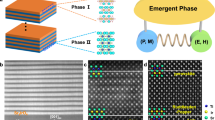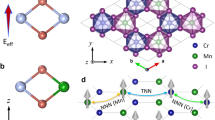Abstract
Magnetism—the spontaneous alignment of atomic moments in a material—is driven by quantum mechanical exchange interactions that operate over interatomic distances. Some magnetic interactions cause1,2, or are caused by3,4, a twisting of arrangements of atoms. This can lead to the magnetoelectric effect, predicted to play a prominent role in future technology, and to the phenomenon of weak ferromagnetism, governed by the so-called Dzyaloshinskii–Moriya interaction5,6,7,8. Here we determine the sign of the latter interaction in iron borate (FeBO3) by using synchrotron radiation. We present a novel experimental technique based on the interference between two X-ray scattering processes, where one acts as a reference wave. Our experimental results are validated by state-of-the-art ab initio calculations. Together, our experimental and theoretical approaches are expected to open up new possibilities for exploring, modelling and exploiting novel magnetic and magnetoelectric materials.
This is a preview of subscription content, access via your institution
Access options
Subscribe to this journal
Receive 12 print issues and online access
$259.00 per year
only $21.58 per issue
Buy this article
- Purchase on SpringerLink
- Instant access to full article PDF
Prices may be subject to local taxes which are calculated during checkout



Similar content being viewed by others
References
Eerenstein, W., Mathur, N. D. & Scott, J. F. Multiferroic and magnetoelectric materials. Nature 442, 759–765 (2006).
Cheong, S-W. & Mostovoy, M. Multiferroics: A magnetic twist for ferroelectricity. Nature Mater. 6, 13–20 (2007).
Rößler, U. K., Bogdanov, A. N. & Pfleiderer, C. Spontaneous skyrmion ground states in magnetic metals. Nature 442, 797–801 (2006).
Yu, X. Z. et al. Real-space observation of a two-dimensional skyrmion crystal. Nature 465, 901–904 (2010).
Dzialoshinskii, I. E. Thermodynamic theory of ‘weak’ ferromagnetism in antiferromagnetic substances. Sov. Phys. JETP 5, 1259–1262 (1957).
Dzyaloshinsky, I. A thermodynamic theory of weak ferromagnetism of antiferromagnetics. J. Phys. Chem. Solids 4, 241–255 (1958).
Moriya, T. New mechanism of anisotropic superexchange interaction. Phys. Rev. Lett. 4, 228–230 (1960).
Moriya, T. Anisotropic superexchange interaction and weak ferromagnetism. Phys. Rev. 120, 91–98 (1960).
Kitzerow, H-S. & Bahr, C. (eds) Chirality in Liquid Crystals (Springer, 2001).
Blundell, S. Magnetism in Condensed Matter (Oxford Univ. Press, 2001).
White, R. M. Quantum Theory of Magnetism (Springer, 2007).
Matarrese, L. W. & Stout, J. W. Magnetic anisotropy of NiF2 . Phys. Rev. 94, 1792–1793 (1954).
Maleyev, S. V. Spin chirality and polarized neutrons. Physica B 350, 26–32 (2004).
Okorokov, A. I. et al. The spin chirality in MnSi single crystal probed by small angle scattering with polarized neutrons. Physica B 350, e323–e326 (2004).
Johnson, R. D. et al. X-ray imaging and multiferroic coupling of cycloidal magnetic domains in ferroelectric monodomain BiFeO3 . Phys. Rev. Lett. 110, 217206 (2013).
Dmitrienko, V. E., Ovchinnikova, E. N., Kokubun, J. & Ishida, K. Dzyaloshinskii–Moriya interaction: How to measure its sign in weak ferromagnets?. JETP Lett. 92, 383–387 (2010).
Blume, M. in Resonant Anomalous X-Ray Scattering (eds Materlik, G., Sparks, C. S. & Fischer, K.) 95–515 (North-Holland, 1994).
De Bergevin, F. & Brunel, M. Diffraction of X-rays by magnetic materials. I. General formulae and measurements on ferro- and ferrimagnetic compounds. Acta Crystallogr. A 37, 314–324 (1981).
Dmitrienko, V. E., Ishida, K., Kirfel, A. & Ovchinnikova, E. N. Polarization anisotropy of X-ray atomic factors and ‘forbidden’ resonant reflections. Acta Crystallogr. A 61, 481–493 (2005).
Lovesey, S. W., Balcar, E., Knight, K. S. & Rodríguez, J. F. Electronic properties of crystalline materials observed in X-ray diffraction. Phys. Rep. 411, 233–289 (2005).
Solovyev, I. V., Lichtenstein, A. I. & Terakura, K. Is Hunds second rule responsible for the orbital magnetism in solids?. Phys. Rev. Lett. 80, 5758–5761 (1998).
Shorikov, A. O., Lukoyanov, A. V., Korotin, M. A. & Anisimov, V. I. Magnetic state and electronic structure of the δ and α phases of metallic Pu and its compounds. Phys. Rev. B 72, 024458 (2005).
Mazurenko, V. V. & Anisimov, V. I. Weak ferromagnetism in antiferromagnets: α-Fe2O3 and La2CuO4 . Phys. Rev. B 71, 184434 (2005).
Yildirim, T., Harris, A. B., Aharony, A. & Entin-Wohlman, O. Anisotropic spin Hamiltonians due to spin–orbit and Coulomb exchange interactions. Phys. Rev. B 52, 10239–10267 (1995).
Solovyev, I., Hamada, N. & Terakura, K. Crucial role of the lattice distortion in the magnetism of LaMnO3 . Phys. Rev. Lett. 76, 4825–4828 (1996).
Katsnelson, M. I., Kvashnin, Y. O., Mazurenko, V. V. & Lichtenstein, A. I. Correlated band theory of spin and orbital contributions to Dzyaloshinskii–Moriya interactions. Phys. Rev. B 82, 100403 (2010).
Brown, S. D. et al. The XMaS beamline at ESRF: Instrumental developments and high resolution diffraction studies. J. Synchrotron Radiat. 8, 1172–1181 (2001).
Collins, S. P. et al. Diamond beamline I16 (materials and magnetism). AIP Conf. Proc. 1234, 303–306 (2009).
Joly, Y. X-ray absorption near-edge structure calculations beyond the muffin-tin approximation. Phys. Rev. B 63, 125120 (2001).
Acknowledgements
The work of V.V.M. is supported by the grant program of the President of Russian Federation MK-5565.2013.2, the contracts of the Ministry of Education and Science of Russia No. 14.A18.21.0076 and 14.A18.21.0889. V.E.D. is grateful for the grant of the Presidium RAS No. 24 ‘Diffraction of synchrotron radiation in multiferroics and chiral magnetics’. M.I.K. acknowledges financial support by FOM (The Netherlands). We thank the staff of ESRF BM-28 for expert assistance, and Y. Shvyd’ko for the loan of the FeBO3 crystal.
Author information
Authors and Affiliations
Contributions
V.E.D. and E.N.O. proposed the project. G.B., S.P.C. and G.N. carried out experimental work at BM-28. S.P.C. carried out experimental work at I16. Y.O.K., V.V.M., A.I.L., M.I.K. performed ab initio calculations. V.E.D. carried out FDMNES calculations. G.B. performed least-squares fitting of model functions to experimental data. G.N. carried out multiple scattering simulations. S.P.C., V.E.D. and V.V.M. wrote the majority of the text.
Corresponding author
Ethics declarations
Competing interests
The authors declare no competing financial interests.
Supplementary information
Supplementary Information
Supplementary Information (PDF 970 kb)
Rights and permissions
About this article
Cite this article
Dmitrienko, V., Ovchinnikova, E., Collins, S. et al. Measuring the Dzyaloshinskii–Moriya interaction in a weak ferromagnet. Nature Phys 10, 202–206 (2014). https://doi.org/10.1038/nphys2859
Received:
Accepted:
Published:
Issue date:
DOI: https://doi.org/10.1038/nphys2859
This article is cited by
-
Revealing emergent magnetic charge in an antiferromagnet with diamond quantum magnetometry
Nature Materials (2024)
-
First-principles calculations for Dzyaloshinskii–Moriya interaction
Nature Reviews Physics (2022)
-
Electrical nucleation, displacement, and detection of antiferromagnetic domain walls in the chiral antiferromagnet Mn3Sn
Communications Physics (2020)
-
Synthesis of antisymmetric spin exchange interaction and chiral spin clusters in superconducting circuits
Nature Physics (2019)
-
Wide-Range Probing of Dzyaloshinskii–Moriya Interaction
Scientific Reports (2017)



